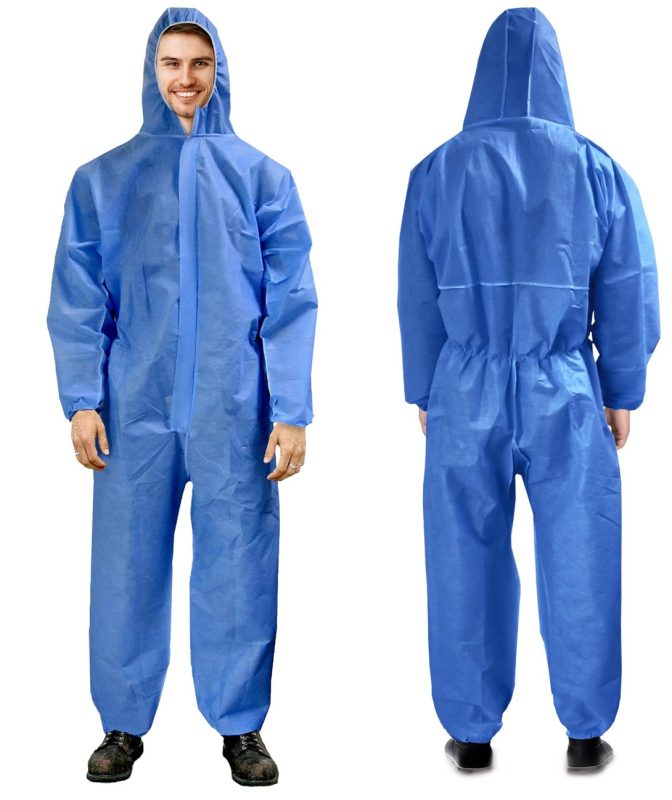When it comes to painting and renovating your home, ensuring personal safety and hygiene is just as important as achieving a perfect finish. Among the essential items for this task, the coverall disposable stands out as a simple yet powerful solution to protect your skin, clothing, and health from paint, dust, and chemical exposure. Designed for one-time use, these protective garments offer full-body coverage, combining practicality with safety — making them a must-have for both professionals and DIY enthusiasts. In this article, we’ll explore why coverall disposable should be a standard part of your toolkit, how to choose the right one, and how to use it effectively during painting and renovation projects.
I. What Is a Coverall? Which Type of Coverall Is Suitable for Painting and Renovation?
To better understand the importance of this protective garment, first we need to understand what a coverall is and which type is most suitable for home painting and renovation work.
1.1 What Is a Coverall Disposable ?
A coverall is a one-piece protective uniform that covers the entire body: arms, legs, front, back, and head. The main types of coveralls are commonly used in various industries such as healthcare, cleanrooms, electronics manufacturing, and light industry. The special feature of coveralls disposable is that they are designed for one-time use, then discarded, ensuring maximum hygiene and eliminating laundering and storage costs.
1.2 Coverall Disposable Coveralls for the Painting and Renovation Industry
In painting and renovation activities, the most suitable coverall disposable must meet the following criteria:
- Disposable coverall that resists dust & light chemicals: This is the key factor to protect users from harmful agents present in the painting environment.
- Material: Should choose ones made from Polypropylene (PP), SMS, or microporous. Each material has distinct characteristics regarding durability, breathability, and protection level.
- Design: Should include a hood, elastic cuffs on arms and legs, with a sealed zipper to ensure the entire body is safely covered.
II. 5 Reasons You Can’t Skip Using Coverall Disposable
Using a coverall disposable brings many practical benefits that many people often overlook. Below are 5 solid reasons why you shouldn’t skip this protective garment when painting a house.
2.1 Protect Skin and Clothing from Paint, Dust, Solvents
Painting a house often involves many types of coatings such as oil-based paint, PU paint, and waterproofing materials. These paints tend to have strong adhesion.
Once paint sticks to clothing, it is very difficult to wash off completely. In many cases, it can permanently ruin your garments.
Furthermore, during the renovation process, tasks like scraping old paint, sanding walls, and cleaning can generate fine dust and airborne particles. These particles easily cling to your clothes and may irritate the skin.
A disposable coverall provides full-body coverage. It creates a physical barrier to block paint, dust, and chemicals from direct contact with your skin or being absorbed into your clothes, keeping you clean and protected.
House paints often contain volatile organic compounds (VOCs) such as toluene, xylene, acetone, formaldehyde. Long-term exposure to these chemicals can cause serious health issues:
• Causes headaches, nausea
• Contact dermatitis, respiratory instability
• In the long term may affect the nervous system and internal organs.
Using a coverall combined with a chemical-filtering mask (not just a regular medical mask) helps minimize the risk of poisoning when painting in enclosed or poorly ventilated spaces.
2.3 Maintain Hygiene During and After Work
Coveralls disposable are consumable. This means you can wear them and immediately replace them after use. The biggest advantage is preventing paint dust, chemicals, or other dirt from being brought home and sticking to furniture, carpets, personal items. This is especially important if you live with children or people with respiratory conditions.
Moreover, using disposable coveralls significantly saves time on laundering and eliminates worries about clothes being damaged by paint.
2.4 Safety When Working at Height
When working on ladders, roofs, high wall corners, or temporary platforms… the risk of slipping, scraping against rough surfaces, or tears on limbs is very high. Coveralls cover arms and legs, greatly reducing scratches, cuts from sharp objects or rough surfaces.
For professional painters, wearing a clean, neat coverall also contributes to professionalism and leaves a good impression on clients.
2.5 More Economical Than Fabric Coveralls
Although reusable fabric coveralls can be worn multiple times, they are often significantly more expensive and require thorough laundering and care after each use. Electricity, water, detergent costs, and wear-and-tear over time must also be considered.
In contrast, disposable coveralls are inexpensive, easy to replace, and very suitable for:
- Part-time workers: No need to invest heavily in initial equipment.
- Post-painting cleaning: Ensuring absolute cleanliness after completing the job.
- DIY home renovation: Saving costs and being convenient for those who renovate themselves.
III. Criteria for Choosing the Right Coverall Disposable for Painting Work
Choosing the right coverall disposable is crucial to ensure protection effectiveness and comfort during work. Below are criteria you need to consider.
3.1 Material
Material determines the protective ability and durability of the coverall. The three most common materials for coveralls disposable are:
- SMS (Spunbond-Meltblown-Spunbond): A combination of three layers of nonwoven fabric. SMS stands out with good dust protection, high durability, and light breathability, providing comfort when worn. It is the ideal choice with reasonable cost for regular home painting jobs.
- Microporous film: Coated with a thin microporous film, it resists light chemicals, water, and effectively waterproofs. Coveralls made of microporous film are highly suitable when working with oil-based paint or in wet areas where there is a high risk of liquid contact.
- Polypropylene (PP): The most basic material, inexpensive and often used for light, short-term work or when only single-use is needed. PP provides basic dust resistance but lacks high chemical resistance or water protection.
3.2 Design
The design of the coverall also directly impacts protection capability and flexibility while working. Choose ones with:
- Hood: To protect hair, ears from paint dust, chemicals, and minor impacts.
- Front zipper with flap cover: The zipper should be easy to use and covered with a flap to stop paint or dust getting through the teeth.
- Elastic cuffs at sleeves and ankles: To snugly fit wrists and ankles, preventing paint, dirt or chemicals from entering inside, and preventing the garment from getting caught during movement.
3.3 Size
Choosing the right size disposable coverall that fits your height and weight is extremely important.
- Do not wear one that is too tight: It will make movement, bending, and squatting difficult, and may cause fabric tearing or tension.
- Do not wear one that is too loose: It can get caught easily, reduce flexibility, and possibly cause danger.
Please refer to manufacturer sizing charts to choose the best-fitting size, ensuring maximum comfort and safety.
3.4 Breathability
In hot working environments or enclosed spaces, breathability becomes extremely important. Prefer types with good ventilation to reduce stuffiness and excessive sweating when working for long periods. Some premium coveralls feature small ventilation holes or breathable zones on the back and armpits to improve air circulation.
IV. Instructions for Proper Use of Coverall When Painting and Renovating a House
Proper use of coveralls not only optimizes protection effectiveness but also ensures safety for you and your surroundings.
4.1 Before Wearing
- Check the coverall: Before wearing, carefully check for tears, stitching defects, or underarm gaps. Even a small tear can significantly reduce protective capability.
- Wear full accompanying PPE: Always ensure you have all other personal protective equipment such as a chemical filter mask (not a regular medical mask), safety goggles, chemical-resistant gloves, and safety shoes. The coverall is only part of a comprehensive protective system.
4.2 While Working
- Avoid removing the coverall mid-task: Refrain from taking off the coverall or other PPE midway, especially while still in dust or chemical environments. Doing so will negate protection effects.
- Avoid fire sources: If using solvent-based paints, absolutely keep away from flames, sparks, or heat-generating items to prevent fire hazards.
- Bend and crouch properly: Perform bending and crouching movements carefully to avoid tearing seams, especially at the crotch and elbows/legs.
4.3 After Use
- Remove carefully: When taking off the coverall, do it slowly and avoid vigorous shaking so that paint dust or chemicals on the surface don’t scatter into the environment. Roll the coverall inside-out to contain the dirty areas inside.
- Dispose according to guidelines: Put the used coverall into a separate plastic bag and dispose of it following industrial or chemical waste procedures. Do not throw it together with regular household waste.
- Personal hygiene: Wash hands and face thoroughly with soap after removing the coverall and other PPE to eliminate any residue paint or chemicals on the skin.
V. Advice for DIY Practitioners and Professionals
Whether you are doing home renovation yourself or are a professional painter, using coverall disposable properly will yield the best results.
5.1 For DIY Home Users
- Use odorless, low‑VOC paint only: If you lack experience handling chemicals, prioritize eco‑friendly paints with low VOC content to minimize exposure risk.
- Always use coverall disposable, goggles, and gloves: Never be careless. These protective items are essential to prevent paint splashes into eyes, skin, or clothes.
- Buy single-packed coveralls: To save costs and avoid waste if you only need them a few times.
5.2 For Professionals
- Keep spare coveralls in your truck: This keeps you prepared for any unexpected site.
- Each job has different conditions, so choose the suitable coverall: For example, use microporous film in wet or oil‑painted areas, and SMS in dry working environments. Flexibility in selection helps optimize protection.
- Create a more professional impression: Wearing clean, neat, and matching uniforms not only protects you but also creates a trustworthy, professional image for clients.
VI. Conclusion: Should You Invest in Coverall Disposable for Painting and Renovating a House?
The answer is yes. With reasonable cost, coverall disposable offer undeniable practical benefits:
- Protect health from paint dust and chemicals: Reducing risks of skin and respiratory diseases caused by direct contact with harmful agents.
- Keep living spaces hygienic: Preventing dust, paint, and chemicals from spreading, keeping your home clean.
- Convenient, easy to use, no laundry needed: Saving time and effort, especially suitable for busy people.
Whether you’re a beginner or a skilled worker, consider coveralls disposable as an essential part of your home renovation tool kit. Safety and professionalism always start with proper protective wear.
VII. Call to Action
TM&DV 8688 Co., Ltd is one of the leading and most reputable companies in Vietnam specializing in the production of disposable protective clothing. Reputation – Quality – Affordable Prices are the core values that 8688 always strives for. So, what are you waiting for? Contact TM&DV 8688 Co., Ltd now or visit 8688.vn for free consultation and find the most suitable coveralls disposable for your needs!

